#even the people who were free but not literally in the submersible came up with us
Text
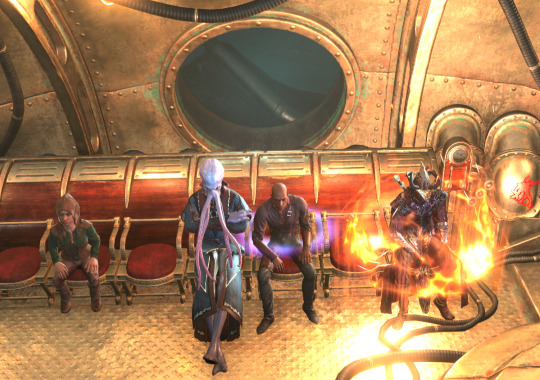
world's most awkward submarine trip
"so, uh, what are you in for?"
#omeluum#ulder ravengard#wyll ravengard#poor ulder#mindflayer on one side#estranged devil son currently on fire on the other#I put ulder one seat away bc the fire and then had omeluum sit right next to him#the subsequent cutscene is KILLING ME#it was Astarion's POV for some reason#he climbed up with halsin beckoning (nvm that he was chilling safely for like 3 turns)#looked over at omeluum with this face of 'I'm not even gonna ask'#went over to Ulder and they hung out awkwardly for a second and Ulder left#I actually got everyone it was so satisfying#even the people who were free but not literally in the submersible came up with us#finding out that ranged attacks open the doors was a huge help#bg3#baldurs gate 3#bg3 spoilers
155 notes
·
View notes
Text
Predictions: How 7x08 Foreshadowed S10-S15
Let me preface this by saying that I’ve had a lot of people asking me for predictions this past week or so. And here they are, but they may not be exactly what you were hoping for. I know everyone wants me to say what episode I think we’ll see her in, but especially given that the finale has been pushed back, there’s just no way to tell, guys. I wish there were.
That said, I think you’ll find this enlightening. I’m SUPER excited about what I found by re-watching 7x08. I just about had a meltdown. So buckle in. This is gonna be a lot to digest but I absolutely love the symbolism in this episode and what it portends for the future of our characters. Including Beth.
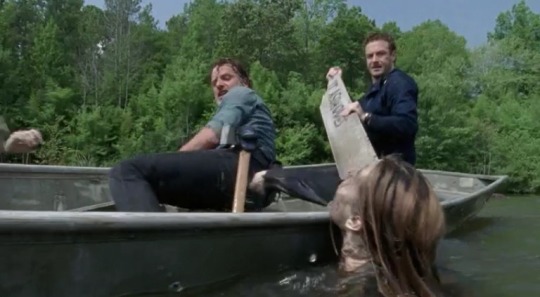
Maggie:
Okay, I’m gonna talk about Maggie first. We start out with Maggie by Glenn’s grave. Then she ascends the scaffold of Hilltop to keep watch. This is where Gregory approaches her with the apple, which I’ll talk about in a minute.
So, when she’s going up the scaffold, I noticed she’s wearing the red shoe laces. And that caught my eye because I’ve long-equated those with the death fake out. But the thing is, this isn’t the death fake out. This is right after Glenn’s REAL death. So I went, “huh. Okay. Why is she wearing those right now? What does it symbolize?” The only thing I could think of was that it simply symbolizes that she’s one of the four death fake out couples.

Then she got to the top of the scaffold. Look at this shot. There’s colorful paint on top of the wooden posts. I know this was talked about back when the episode aired, because it’s red and green paint. I just didn’t have anything other than the obvious red/green stuff to say about it. But it REALLY jumped out at me this time. There are THREE daubs of green paint and ONE daub of red. We have FOUR fake out couples (Richonne, Bethyl. Glaggie, and Carzekiel) but only three pickle resurrections. Do you see? I think this foreshadows that we have four death fake-outs, and three of them will “return” from the dead, but Glenn is dead for real. This is how they’re showing that.
Furthermore, I want to return to 6x08 when the church fell, and the walkers got in and Maggie had to get up the ladder or die. That’s one big place when we saw red and green together, including Maggie’s red shoelaces. But the thing is, we saw a green cord next to them. So that symbolized death (Glenn��s death fake-out) but that he would return/be resurrected this time (green cord). There is no green cord paired with Maggie’s shoelaces, because Glenn is dead for real.

So, not anything we didn’t already know, but it’s awesome to see them symbolize it this way. And of course, we simply didn’t understand enough about the symbolism back then to connect these things.
Apples
I said after watching 10x13 that apples represent separation from one’s family or loved ones, right? Well, 7x08 is where we see a lot of apples around Maggie.

And while I think it could represent her separation from Glenn because of his death—it probably does, at least in part—it also represents her separation from TF. Because after Glenn’s death, she went on to HT by herself.
Yes, she had Sasha and Enid and Jesus around her, but she was separated from the core group—Rick, Michonne, Daryl (those three in particular are important because they and Maggie are the only ones still alive in the show right now)—who were back at Alexandria, or, in Daryl’s case, at the Sanctuary. So the apples were to show her separation from TF in general.
And that’s SUPER important because where we are now, in S10, she’s been separated from TF for a while. Since S9. But we know she’ll be returning soon. And I do think this was one great big foreshadow of what is happening in the narrative right now. I’ll come back to the reunion at the end. Cuz it’s HUBONGOUS! (As my nephew would say. 😉)
I want to point out something that actually isn’t in this episode, because I know we talked about it. Back in 6x15, the one where Daryl strikes off on his own to get revenge for Denise, and that’s how he and Glenn and everyone get captured by Negan, we had a bedroom scene between Rick and Michonne where they both ate an apple.

I think that, too, represents separation. Obviously they’re together at that point, but it’s a foreshadow of two different things. First off, it’s a foreshadow of them being emotionally separated in 7a.
So, in that bedroom scene, they talk about being on top of the world and being able to deal with anything and hope for the future. That all gets shot to hell when Abraham and Glenn die. And for all of 7a, Rick is bowing to Negan while Michonne wants to fight him. They’re not on the same page at all. The reason I thought of this is not only because of the apple, but because that emotional separation ends in 7x08 when Rick says he’s finally ready to fight Negan.
But just to illustrate, we saw Michonne off on her own a lot in 7a. She went and shot the deer, in this episode she had the one Savior at gun point trying to find out where the Sanctuary was, etc. In the episode where she shot the deer, she woke up in bed with Rick, and they were on opposite sides of the bed, not touching each other and facing away from one another.
The exact opposite of when they were cuddling in 6x15. So again, just show that there was emotional distance there. So the apple they ate together foreshadowed that. We didn’t see them eating apples together again once they were on the same page again and fighting Negan.
But I also think it foreshadowed them being apart after Rick disappears from the bridge. I have proof that it does, but let me get there. Gotta mention other things first.
Spencer
Kind of minor things here. He definitely has parallels to Beth (lost shoe symbolism, brings Negan alcohol here, etc). And I know no one likes that fact because Spencer was such a douche.But I usually view him as an anti-parallel to Beth.

The way I see it, he tried to suck up to Negan and it got him killed. Beth refused to suck up to Dawn. On the contrary, she fought her. And while it did get her shot, we know that ultimately, she’ll live. And I’ve often wondered if they’re trying to establish something saying that the only reason Beth DID survive long term is BECAUSE she was shot. Otherwise, she might not have. I don’t know why that would be, but given the anti-parallel to Spencer, it might be a theme.
So, the thing I wanted to point out about Spencer happens at the beginning. As the episode begins, he returns with supplies. Remember, he found the stash of supplies and a corpse in a tree with a cross bow? Well, he brings them back, covered with blood. One of the male Saviors and Laura (blond gal Beta recently killed) meet him.
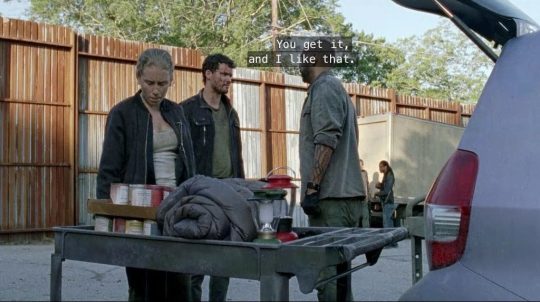
First, the male savior says he did good. He says, “You get it and I like that.” Beth said “I get it,” so saying “you get it” to Spencer establishes him as a Beth proxy. It’s what first caught my ear about this scene. Then the guy says, “You obviously fought for this and I like that.” So, obviously Beth fought for stuff. But it also reminded me of the what Glenn said to Maggie in Them. “We fought to be here.”
Then Laura hits on him. She’s been seen as an anti-Beth thing as well, especially around Dwight. And mostly because of the blond hair. I think it’s Spencer who represents Beth here, but they might have thrown the blond into the mix for good measure. And let’s appreciate that Spencer brought back a cross bow…
And on top of it all, Eugene is watching this. So we have Eugene kind of observing an anti-Bethyl hookup in progress, lol. (Such a weird sentence.) Anyway, more evidence to me of Eugene’s story line leading to Beth.
Also, I was kind of thinking that Spencer wanted Negan to kill Rick and put him in charge, right? So, he kind of wanted to be…the new sheriff. But obviously he’s not. Beth is. Suck it, Spencer!
Also, also: Carl’s actions led to Spencer’s death. Don’t get me wrong, Spencer was a doofas and made his own decisions, but the only reason Negan was even there was because Carl went to the Sanctuary and Negan brought him back. How many times have we said Carl’s death will lead to Beth’s return?
Michonne:

I saw parallels (anti-parallels) between Michonne killing the Savior woman in 7x08 and the emphasis they put on her deciding to help people (like Andrea) in 10x13. Mostly, she was in an opposite place here in 7x08 than she is in 10x13.
And I think that’s why these episodes connect so heavily. Opposite things are happening. Spencer died but Beth will return. Rick was bowing to Negan here, but in 10x13, they’re fighting for their freedom, both from the Whisperers and now Michonne will fight to free Rick from the helicopter people. In 7x08, she actually killed that Savior woman, which was pretty brutal for Michonne. In tonight’s episode, there’s a big emphasis on her choices to help Andrea, and then others. More about the overall arc in a second.
Oh, also, TD made a big deal about this picture of the crustacean on the wall behind Sasha. We were already connecting it to the ocean theme.

And there was a lot said about the red hat next to the green coverlet on the bed. In 10x13, we literally see red crustaceans in the water next to Rick’s boat. Not sure what that means, yet. I’m just saying.

Rick and Aaron (the Big Cheese)
So, when @wdway watched 7x08, she said this:
“There was something I wanted to make a connection about water and almost drowning but I wanted to make sure that it was Aaron who went into the water and it was. He fell in, completely went under the water and came back up, surrounded with Walkers, made it to the houseboat and climbed up the ladder. He's wearing a bone handled knife on his left hip, looks a lot like Beth's knife. He collapses on the houseboat with the binoculars right above his head and then he helps Rick onto the boat and both collapse on the deck.
What I want to suggest a possibility about drowning or almost drowning I'm looking at it as a resurrection symbol. In many denominations, baptism is by submersion. You stand in the water, you are lowered completely under the water and then brought back up. It is a symbolic act of being buried and then rising up as a new person, being Resurrected. It's obvious that Aaron is a Beth proxy and we just saw him almost drown, baptized and resurrected from it and then laid next to Rick, the other Christ figure in TWD. And then you just told us that Michonne is told of Rick almost drowning. Actually, twice they believed he might have drowned [because of] when the bridge blew up.

It gets better, though, because from Aaron and Rick lying side-by-side on the boat deck in this scene.
Middle finger is very much Beth symbol. That is found soon after Aaron gets up from the deck and yes, Aaron's the one that found the finger, tying it to him as a Beth proxy.
This episode is incredible looking back at it. We have FG and Rosita in the AZ Church I think the start or their relationship, we just didn't know it for three more seasons.

We had Negan playing pool with Spencer who sets the balls up. Look at the numbers here.

We see a 9 and a 4. s9e4 was The Obliged, the first of the two-part episodes of Rick leaving. The fun thing here is that literally before we see the 9 and 4, they say Rick's name, the conversation consists of getting rid of Rick.
Something I wanted to point out, which we have talked about in the past, but the name of the episode is Hearts Still Beating that damn word "Still" but then it's repeated in the note with the finger. They use the word still in it.”

Okay, I second all of that. Great stuff. Plus, on Sunday I answered THIS ASK , in which Nonny pointed out that some time ago, Norman tweeted the song, Drowning Man by U2. So this is obviously a theme Norman is dropping hints about. There’s also the fact that 8 is the scriptoral number for baptism. So the 8, while I still think it does represent 8 years, may also hint at that theme.
So everything @wdway said is absolutely true.
I also had the idea from watching 10x13 that maybe Rick almost drowned and Beth is the one that saved him. I went into my re-watch of 7x08 looking for evidence of Beth saving Rick in some way. And I didn’t find that specifically, but I found so much more! First, let’s remember that Aaron is a Beth proxy here. We’ve already established that. So in this analogy, Aaron = Beth, yeah?
Here’s what I’m seeing from the lake/boat house scene. There are actually three boats. That’s obviously purposeful. The first one is full of bullet holes (foreshadow much?) and they know it will take on water fast. So they need to get to the second boat, a canoe, before that happens, and then they’ll take the canoe to the houseboat which is their goal (because supplies). So the houseboat is the third boat.
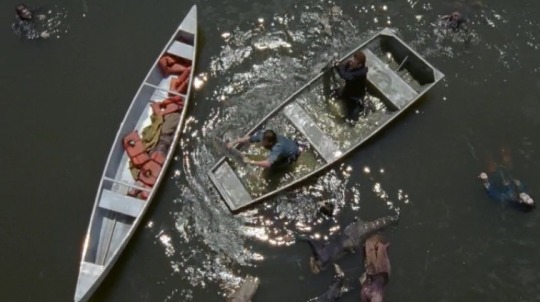
I think the first boat represents the first 5 seasons of the show, in which Beth and Rick are together (Rick and Aaron both in the boat). Not always in the exact same place (and okay, season 2-5) but they’re in the same group and on the same page and fighting for the same things.

When Aaron reaches the canoe, a female walker (dark haired) suddenly sits up. She was completely invisible beneath the life vests. So, what’s unseen, walkers, and resurrection. Mostly, I see her as representing the walker horde that had to do with Beth being left behind. Why? Because this is where Aaron goes into the water Beth). It’s where he disappears and is lost (Beth). We see Rick looking frantic and then really upset because he thinks Aaron just died. But thankfully, Aaron resurfaces in a different spot than where he disappeared (Beth!) and Rick is relieved that he’s okay.

So reaching the second boat = Grady, Beth being shot and left behind. Rick is then alone in the second boat (without Beth), so it represents the next 5 seasons of the show, in which Beth and Rick are NOT in the same place. Aaron never actually spends any time in the canoe.
Then Aaron makes his way to the houseboat by swimming through the water while Rick goes via the canoe.
I really loved what @wdway said about him and Rick lying side by side, representing the two Christic figures. The first thing I saw was Aaron lying next to the female walker, which is the Bethyl side-by-side theme. But I also think it’s a blatant hint that Aaron = Beth. Because the female walker in that theme is always Beth. So lying him next to her is them showing us that he’s a proxy.
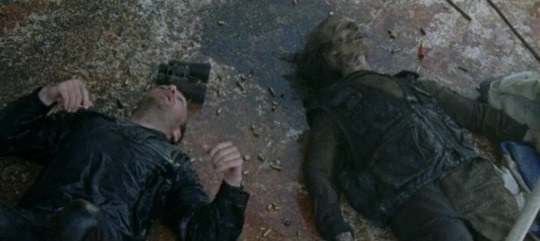
But I really love the idea of the side by side theme being about two Christic figures. I mean, even considering Beth and Daryl, they’ve both had their own dark tunnel arcs. They’ve both been separated and come back together. I’m also thinking about Karen and David, who were “sacrificed” by Carol. There’s even two side by side cops (sheriffs) in 2x10 that Rick and Shane stare at. Two sheriffs, represented her by Rick and Aaron (Beth).
Anyway, let me add something to this houseboat thing, though. I think we should take everything that happens in this scene…well, to “literal foreshadow” is an contradiction, but I mean we should read it as things that will happen literally in the narrative it is foreshadowing. So there really could be a drowning/swimming component for Beth on her way to the helicopter people. That would support the drowning man theme and explain all the boat, water, sea, sailor stuff around her.
But what really struck me is that Aaron made it to the houseboat first. When Rick got there, he was already there.
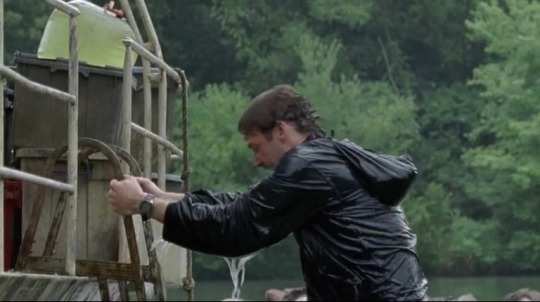
Do you see? So the houseboat (third boat) represents the final 5 seasons of the show, in which the helicopter people will be the thing they’re fighting against. It represents the helicopter group in general. Beth got there first, and was already there when Rick arrived. But the two sheriffs are there together.
Then what happens? Aaron says something about the wind picking up and the boat drifts back to the shore on its own, where they unload the supplies, including the drawing of the flip off finger with the word “still” on it.

So my first thought is that they will return together. I mean, Rick and Aaron return to Alexandria together by the end of the episode, right? And are both reunited with their significant others. But I’m gonna show you something in a minute that makes me doubt that will be the case. I mean, it’s true in a general sense. They’ll help each other both return. But I still think Beth will reach Daryl before Rick does. I’ll show you why in a minute.
So then, while unloading the supplies, Rick and Aaron have a discussion about being subjugated to Negan. Aaron talks about how it’s a big decision for people like them, who have fought to be free, to decide to placate a dictator like Negan. But Aaron says they’re doing it to protect the lives of their loved ones.
So it’s basically a convo about imprisonment. More evidence of Beth and Rick being imprisoned together somewhere. But I also wonder if it shows they’ll make a decision to specifically not return to TF right away in order to protect them in some way. It might explain the 6-year absence. But of course, just as TF eventually fought Negan, that decision will change, and Rick and Beth will return, and TF will fight the helicopter people. (Yea!)
Rick and Michonne:
Okay, so now that we’ve established this, let’s talk about Rick and Michonne’s “reunion” at Alexandria. It’s a reunion because of the emotional space between them, but take a look at the symbolism of how this reunion takes place.

Rick is kneeling inside a freaking jail cell, holding the paper that has the flip off finger and the word “still” on it. (I’m sure that ax is highly symbolic, too. Aside from just the obvious walker weapon, but I’m not sure what it means.) This is why this emotional distance foreshadows he and Michonne being separated from S9-S10. Because when they reunite, he’s in a prison (helicopter people)…with Beth (flip off/Still paper).
Yeah, this is why I was freaking out watching this episode. There’s SO much. And again, we didn’t even know about Rick leaving in this season, so there’s NO WAY we could have figured this out. But it’s so epic!
And, for the record, he and Michonne have a make out session. (A.k.a. epic reunion. 😉)

Okay, you dizzy yet? I have one more major thing to talk about and then I’ll let you breathe.
The Hilltop Reunions:

Think about this. We had Maggie separated from TF, which foreshadows her current absence on the show. But she and Daryl came back together first, once he escaped the Sanctuary. That will be happening this season as we know Maggie is returning and then she and Daryl will be in the same place again.
Meanwhile, Michonne has gone to find Rick.
So, as beautiful as Rick and Daryl’s hug was in this scene, it also foreshadows their reunion when Rick RETURNS from the helicopter group. Daryl and Maggie will be in one place, and Rick and Michonne will return together to reunite with them both.
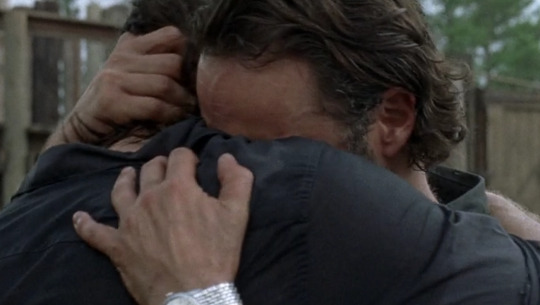
Of course there are others in this scene, such as Sasha, Carl, and Enid, but they’ve all passed on and won’t figure in the current narrative. I’m wondering what to read into the fact that Rosita arrives with Rick and Michonne. Hmm.
Now, there’s really only one thing this scene is missing: our Beth proxy. I was thinking that I would have liked it better if Aaron had gone with them, because then we would be seeing Beth arrive as well. But there’s a specific reason I think he didn’t, and this is also why I think Beth will reunite with Daryl before Rick will. Who else is in this scene?
That would be Jesus. And I think it’s especially purposeful that when Daryl comes out from behind the building to see Rick, Jesus is with him. Like they’ve been hanging out together.

So if Jesus represents Beth, then she’ll already be there when Rick arrives. She and Daryl will have already reunited. Which is kind of what we suspected would be the case anyway. But that’s why they didn’t have Aaron arrive at HT with Rick. That would have foreshadowed something incorrect.
And of course, from there, we can actually backtrack the Jesus thing. The fact that Daryl was imprisoned and Jesus went to get him. That could be a Beth thing. We could keep going, but we won’t. 😉
So yeah. I’m so excited about this, I kinda can’t sit still.

Oh, and about the 15 seasons? Did you notice the number on the side of the boat I sent you? It’s 672. We could obviously assign a lot of value to each of those numbers, but they add up to 15.
I think that represents the 15 seasons Gimple has said he has planned. And seeing them here signals that we’re moving into the final third of the story. Michonne’s whole arc now will revolve around Rick and the helicopter people. Seeing this number as she goes to find him signals that this part of the story has arrived, and it will carry us out to season 15.
Oh, and 7x08? It’s EXACTLY half way through 15 seasons. You might call it the Shape of Things to Come. (Sorry. This was something my fellow theorists and I were talking about. I need to go back and research this more, but the name of the book Eugene read while sitting on the firetruck in 5x05 was “The Shape of Things to Come.”)
I’m gonna stop there because this is already long, but keep in mind, I haven’t even covered the fact that after this Aaron/Rick/boat scene, we see Boots (with all the Beth symbolism) watching. It’s Tamiel, who’s part of the Scavengers, who just so happen to be in contact with the helicopter group. We couldn’t have known that then, but what a foreshadow!



I also didn’t cover Daryl’s escape from the Sanctuary, mostly because I’ve already talked a lot about that recently. But this was the episode with the 10:16 clock, where we see his scars, the pickles spilling, him eating peanut butter, etc.

And then there’s the fact that there’s a CODA to this episode, where Tamiel follows Aaron and Rick back to Alexandria and spies on them.

Juuuuuust saying. 😉
#beth greene#beth greene lives#beth is alive#beth is coming#td theory#td theories#team delusional#team defiance#beth is almost here#bethyl
9 notes
·
View notes
Text
Life on the Road: Week 1, France
A week ago we had just reached French shores and stayed the night near the Belgium border. Now, over a thousand kilometres later, I look back at life on the road in Suzi the HiAce.

The days before we left England, I was filled with nerves. A weird sort of apprehension-excitement-fear combo descended on me, especially as George left me alone for a day whilst he headed up to Manchester to do a last-minute video shoot. Then, Monday morning finally came and I was so glad we were ready to leave, given that my mind had been running in circles in the days prior.
Even if we had forgotten things, not planned for certain eventualities, I was ready to go and to start our long-awaited trip.
The drive to Dover was somewhat uneventful, punctuated by a welcome visit at my Aunt’s house in Ashford, and a lovely meal, sharing stories of places travelled and frantically jotting notes down from my knowledgeable relatives about the best routes to take (and tolls to avoid!) in France. We arrived at the ferry terminal with ages to spare, an unusual departure from George and my usual tendency to leave everything to the last minute.
Once on French soil, we really enjoyed taking in the surroundings of the north coast. Although an altogether flat and industrial area, Dunkirk and the neighbouring villages were peppered with characterful qualities: the ‘Gilets Jaunes’ hosting small road-side bonfires, faded signage painted on brick facades, and unusual Flemish-style housing with tiled roofs and shuttered windows. We started to search online for the history of places we saw and towns we passed through, often discovering impressive stories from both the world wars of soldiers’ resistance and the resilience of ordinary local folk. This activity of reading a place’s Wikipedia page as evening entertainment has become a bit of a habit!

(images, left to right) Exploring the streets of Dunkirk, a much-needed celebratory champagne/beer on the ferry from Dover, and me outside Suzi on our drive to Paris.
En route to Paris, we risked the tolls and experienced the aggression of French drivers when they get stuck behind a 25-year old fully-laden campervan. Tolls are something we’re generally going to avoid; whilst they save you time, we’d rather save the money and enjoy the more scenic routes. But in this instance, we got to France’s capital nice and quickly, and found free showers at the roadside services as a bonus.
The two and a half days we spent in Paris were just perfect: we kept things slow and cheap rather than trying to see and do everything.
Based on advice from other vanlifers, we opted to park up in a suburb on the outskirts of the city and catch the train each day. Despite protests from railway workers and closed train lines making headline news whilst we were there, the line we took seemed unaffected and it worked out brilliantly - we would pop up at the station outside Notre Dame, and each day take in the sights of the city by foot. Road closures left streets feeling calm and quiet, combined with the fact that the freezing cold temperatures were keeping the crowds away!
Generally, we mooched around the Quartier Latin and the student areas, centred on the Pantheon and Rue Mouffetard, the city’s oldest street. I was impressed to see sustainable, human-centred initiatives across the city, no-doubt linked to the forward-thinking stance of Paris’ mayor, Anne Hidalgo (a renowned figure in urban design circles). There were lots of bicycles, generous pedestrian spaces, electric car charging stations and even billboards announcing the city’s ‘participatory budgeting’ scheme, although the lack of green spaces and trees was apparent too.

(images, left to right) Filming in Le Jardin du Luxembourg, wandering along the Seine, and escaping from the cold in a super-cool Parisien cafe.
We were lucky enough to catch up with friends and family in Paris, which made the big city feel warm and welcoming.
On the first night, a girl who I had met back in Sydney when we both volunteered at a not-for-profit restaurant met up with us and showed us the local’s perspective into the best inner-city spots for wandering and socialising. On Thursday, what began as George randomly spotting that an old bandmate of his was also in Paris, resulted in a couple of beers that evening with him and his girlfriend. And the next day, we were able to see one of my cousins, along with his wife and newborn baby, in their apartment in the 11th arrondissement. These encounters were so enjoyable, and were a powerful reminder that it will be the people we see and spend time with along this trip that define it.
Sad to leave but ready for the next step, we left Paris in the knowledge that life admin was on the cards. We wanted to get a gas refill for our spare gas bottle so that when we run out on our first tank in some middle-of-nowhere location, we don’t have to eat cold spaghetti! After a few delightful days of being tourists in Paris, including filming our first episode of ‘Place Portraits’ about film photography through our documentary channel Broaden, spending a tireless day looking for the right gas refill felt like a fall from grace.
We quickly learned that all the little things like gas, electricity and water can take up a lot of time when you’re living in a van and you’re in a foreign country.
Eventually laden with a new (albeit pricey) bottle of gas, we headed out towards the countryside to find somewhere to stay for the night. We didn’t get that far, and stopped in the town of Fontainbleu - renowned for its historic connections to French royalty (also worth checking out the Wikipedia page). We found our parking spot through the fantastic app ‘Park4Night’, and this location reaffirmed just how awesome the app can be, as it led us to a space literally outside the gates to Fontainbleu Castle!

(images, left to right) A morning run around Fontainbleu Castle, a very excitable me after said run, and our epic camping spot outside the castle gates.
One of mine and George’s priorities has been to squeeze in exercise along the journey. Staying active is not only important to the two of us, but essential when you’re often sitting still in a van for long distances. The only thing getting in the way of doing lots of exercise is the fact that we don’t have a shower (though we’re looking into a small one with submersible pump and would love recommendations from folks who have used them before). Nonetheless, we did a 5K run around the eery castle grounds at Fontainbleu, and I’ve tailored a workout with the NikeTraining app that I can just about do lying in the van. As for the washing situation, well it’s either boiling a kettle and doing a face-cloth shower, or heading to public swimming pools (as we did in Lyon) and making use of the facilities whilst squeezing a swim in as well.
With dreams of snow, we spent two days headed south-east, through Lyon, towards the Alps. Unfortunately, it turned out to be a bit of a half-baked plan and we eventually decided to give up on the idea.
We had gotten quite close to the Alps before we decided it wasn’t worth it. We’d been tracking slower than expected, and had generally realised that Suzi can’t just whizz up hilly roads as we’d like. Given that we also had no plans to ski (and were just headed there for the views and hikes), it felt like a huge commitment for not all that much reward. It was a frustrating decision, but a good first experience in the reality of trip-planning and timing.
Almost a week in, and it felt like we’d hit our first slump: giving up on the Alps and generally being aware that Suzi is an old van with a somewhat unreliable engine. Although we’ve had no issues with her so far, other than underwhelming fuel efficiency, George is conscious that we may have worn piston rings. The piston rings are something that could cause us issues in the future, so we’re closely monitoring them for now and on the look-out for a reliable garage in South France/Spain that may be able to have a look at them and give us an idea of what repairs may cost.

(images, left to right) Emptying the wastewater tank and filling up on fresh water at an ‘Aire du Camping-Car’, stocking up on much-needed bread and cheese, and editing footage inside the van in true hot-desking style!
Changing the plan and re-diverting west turned out to be a real positive. We ventured along some alpine roads through the stunning scenery of the Parc Natural Regional Livradois-Forez and ended the first week on a high - parked up in the middle of nowhere safe and sound in the van.
That evening, we ate fresh baguette with local cheese and snuggled under our blanket watching a BBC crime drama. With no other sign of life in sight, we finally felt free - next to a stream in a misty forest, accompanied by the soundtrack of light rain. It wasn’t the most stunning place, the most famous or the most extreme, but it was just right.
#traveldiaries#SuzitheVan#ToyotaHiace#OverlandAdventures#DigitalNomads#BryonyandGeorge#vanlife#hiacevan#lifethroughalens#vanliving#consciouscommunity
1 note
·
View note
Text
Church Ordinances
New Testament Christianity is not a ritualistic religion; the essence of Christianity is man's direct contact with God through the Spirit. Therefore, there is no dogmatic and inflexible order of worship, but rather allowing the church, in all times and countries, the freedom to adopt the method that is most appropriate for the expression of its life. Nevertheless, there are two ceremonies that are essential, as they are divinely ordained, namely, water baptism and the Lord's Supper.
Because of their sacred character, they are sometimes described as sacraments, literally, "sacred things", or "oaths consecrated by a sacred rite". They are also referred to as ordinances because they are "ordained" by the Lord Himself.
Water baptism is the rite of entry into the Christian church, and symbolizes the beginning of spiritual life. The Lord's Supper is the rite of communion and means the continuation of the spiritual life. The first suggests faith in Christ; the second suggests communion with Christ. The first is administered only once, because there can be only one beginning of the spiritual life; the second is administered frequently, teaching that the spiritual life must be nourished.
1. Baptism.
(a) The mode. The word "baptize", used in the formula of Matthew 28: 19.20. it literally means to dive or immerse. This interpretation is confirmed by Greek scholars and church historians. Even scholars belonging to churches that baptize by sprinkling admit that immersion was the primitive way of baptizing. Furthermore, there are reasons to believe that for Jews in apostolic times, the command to be "baptized" would suggest "proselyte baptism", which meant the conversion of a pagan to Judaism. The convert was standing in the water, up to his neck, while the law was being read, after which he himself submerged himself in the water, as a sign that he had been purified from the defilements of paganism and that he had started a new life as a member of the covenant people. . Where, then, did the practice of sprinkling and pouring water?
When the church abandoned the simplicity of the New Testament, and was influenced by pagan ideas, it attached unbiblical importance to water baptism, which came to be considered entirely essential for achieving regeneration. It was therefore administered to the sick and dying. Since immersion was not possible in such cases, baptism was administered by spraying. Later, because of the convenience of the method, it became widespread. Also, because of the importance of the ordinance, it was allowed to spill water when there was not enough to practice immersion.
Note the following quote from an old second century writer, now concerning baptism, baptize like this: having taught all these things, baptize in the name of the Father, the Son, and the Holy Spirit, in living (flowing) water. And if you don't have living water, baptize in another water; and if you can't in cold water, then in warm water. But if you have neither, pour water three times on your head, in the name of the Father and the Son and the Holy Spirit. Nevertheless, the biblical and original way is immersion, which corresponds to the symbolic meaning of baptism, namely, death, burial and resurrection. (Rom. 6: 1-4.)
(b) The formula. "Baptizing them in the name of the Father, and of the Son and of the Holy Spirit" (Matt. 28:19). How are we going to reconcile this with Peter's command: "... each one of you be baptized in the name of Jesus Christ"? (Acts 2:38). These last words do not represent a baptismal formula, but a simple statement stating that people who recognized Jesus as Lord and Christ were baptized. For example, "Didaquê", a Christian document written around 100 A.D., speaks of Christian baptism celebrated in the name of the Lord Jesus, but the same document, when describing the rite in detail, uses the Trinitarian formula.
When Paul says that Israel was baptized in the Red Sea "in Moses", he does not refer to a formula that was pronounced at the time; it simply means that, because of the miraculous passage through the Red Sea, the Israelites accepted Moses as their guide and teacher as an envoy from heaven. In the same way, being baptized in the name of Jesus means committing oneself entirely and eternally to him as a Savior sent from heaven, and the acceptance of his direction imposes the acceptance of the formula given by Jesus in the 28th chapter of Matthew. The literal translation of Acts 2:38 is: "be baptized under the name of Jesus Christ".
This means, according to Thayer's dictionary, that the Jews were to "rest their hope and confidence in their messianic authority". Note that the Trinitarian formula is described in an experiment. Those who are baptized in the name of the triune God are hereby testifying that they have been immersed in spiritual communion with the Trinity. In this way it can be said about them: "The grace of the Lord Jesus Christ and the love of God, and the fellowship of the Holy Spirit be with you all" (2 Cor. 13:13).
(c) The container. All who sincerely repent of their sin, profess their faith in the Lord Jesus, are eligible for baptism. In the apostolic church the rite was accompanied by the following external expressions:
1) Profession of faith. (Acts 8:37.)
2) Prayer. (Acts 22:16.)
3) Consecration vote. (1 Pet. 3:21.)
Since infants have no sins to repent of and cannot exercise their faith, they are logically excluded from water baptism. Therefore, we are not preventing them from coming to Christ (Matt. 19: 13,14), as they can be consecrated to Jesus in public worship.
(d) Effectiveness. Water baptism has no power in itself to save; people are baptized, not to be saved, but because they are already saved. Therefore, we cannot say that the rite is absolutely essential for salvation. But we can insist that it is essential for complete obedience to Christ. As the election of the president of the nation is completed by his possession of the government, so the election of the convert by the grace and glory of God is completed by his public admission as a member of the church of Christ.
(e) The meaning. Baptism suggests the following ideas:
1) Salvation. Water baptism is a sacred drama (if we are allowed to speak this way), representing the foundations of the Gospel. The convert's descent into the waters portrays Christ's death effected; the convert's submersion speaks of ratified death, that is, his burial; the raising of the convert means the conquest over death, that is, the resurrection of Christ.
2) Experience. The fact that these acts are performed with the convert himself shows that he has identified himself spiritually with Christ. Immersion proclaims the following message: "Christ died for sin so that this man died for sin." The convert's survey expresses the following message: "Christ was raised from the dead so that this man could live a new life of justice."
3) Regeneration. The experience of the new birth has been described as a "washing" (literally "bathing", Titus 3: 5), because through it, the sins and defilements of the life of yore were washed away. Just as washing with water cleanses the body, so also God, in union with the death of Christ and by the Holy Spirit, purifies the soul. Water baptism symbolizes this purification. "Arise, and wash away your sins (that is, as a sign of what has already been accomplished)" (Acts 22:16).
4) Testimony. "For as many as you have been baptized into Christ have put on Christ" (Gal. 3:27). Water baptism means that the convert, by faith, "clothed" himself in the character of Christ so that men can see Christ in him, as seen in the uniform of the soldier. By the rite of baptism, the convert, figuratively speaking, publicly wears the uniform of the kingdom of Christ.
2. The Lord's Supper. Main points.
The Lord's Supper or Communion is defined as the distinctive rite of Christian worship, instituted by the Lord Jesus on the eve of his atoning death. It consists of the solemn participation of bread and wine, which, being presented to the Father in memory of Christ's inexhaustible sacrifice, become a means of grace by which we are encouraged to a more lively faith and greater fidelity to him. The following are the key points of this ordinance:
(a) Celebration. "Do this in remembrance of me." Every year, on the 4th of July, the American people remember in a special way the event that made them a free people. (*) Every time a group of Christians congregate to celebrate the Lord's Supper, they are celebrating, in a special way, the atoning death of Christ who freed them from sins. Why remember his death more than any other event in his life? Because his death was the culmination of his ministry and because we are saved, not merely by his life and teachings, although they are divine, but by his atoning sacrifice.
(b) Instruction. The Lord's Supper is an objective lesson that exposes the two foundations of the Gospel:
1) The incarnation. As we partake of the bread, we hear the apostle John say: "And the Word became flesh and dwelt among us" (John 1:14); we hear the Lord Himself declare, "For the bread of God is that which comes down from heaven and gives life to the world" (John 6:33).
2) The atonement. But the blessings included in the incarnation are bestowed upon us through the death of Christ. Bread and wine symbolize two results of death: the separation of the body and life, and the separation of flesh and blood. The symbolism of the broken bread is that the bread must be broken at death (Calvary) in order to be distributed among the spiritually hungry; the spilled wine tells us that the blood of Christ, which is his life, must be spilled in death so that its purifying and life-giving power can be bestowed on needy souls.
(c) Inspiration. The elements, especially wine, remind us that by faith we can be partakers of the nature of Christ, that is, have "fellowship with him". By participating in the bread and wine of the Supper, the act reminds us and assures us that, by faith, we can truly receive the Spirit of Christ and be a reflection of his character.
(d) Security. This cup is the New Testament in my blood "! (1 Cor. 11:25). In ancient times the most solemn form of covenant was the blood covenant, which was sealed or made with sacrificial blood. The covenant made with Israel in the Monto Sinai was a blood covenant. After God exposed his conditions and the people accepted them, Moses took a basin full of sacrificial blood and sprinkled half on the altar of sacrifice, meaning that this act God had committed to fulfill. his part of the covenant, then he sprinkled the rest of the blood on the people, thereby committing them to keep their share of the contract as well (Ex. 24: 3-8).
The new covenant signed by Jesus is a blood covenant. God accepted the blood of Christ (Heb.?); therefore, he committed himself, for the sake of Christ, to forgive and save all who come to him. The blood of Christ is the divine guarantee that he will be benevolent and merciful to one who repents. Our part in that contract is to believe in Christ's atoning death. (Rom. 3: 25,26.) Then, we can then testify that they were sprinkled with the blood of the new covenant. (1Ped. 1: 2.)
(e) Responsibility. Who should be admitted or excluded from the Lord's Table? Paul addresses the issue of those worthy of the sacrament in 1Cor. 11: 20-34. "Therefore, anyone who eats this bread, or drinks this cup of the Lord unworthily, will be guilty (an offense or sin against) the body and blood of the Lord." Does this mean that only those who are worthy can come to the Lord's Table? So, we are all excluded! For who among the children of men is worthy of the least of God's mercies? No, the apostle is not talking about the unworthiness of people, but the unworthiness of actions. So, strange as it may seem, it is possible for an unworthy person to participate with dignity.
And in a sense, only those who sincerely feel their unworthiness are able to approach the Bureau; those who justify themselves will never be worthy. Furthermore, it is noted that the most profoundly spiritual people are those who most feel their unworthiness. Paul describes himself as the "chief of sinners" (1 Tim. 1:15). The apostle warns us against unworthy acts and unworthy attitude when participating in this sacrament. How can anyone participate unworthily? Practicing something that prevents us from clearly appreciating the meaning of the elements, and from approaching in a solemn, meditative and reverent attitude. In the case of the Corinthians, the impediment was serious, namely drunkenness. ... As Ordenanças da Igreja
O Cristianismo no Novo Testamento não é uma religião ritualista; a essência do Cristianismo é o contato direto do homem com Deus por meio do Espírito. Portanto, não há uma ordem de adoração dogmática e inflexível, antes permitir à igreja, em todos os tempos e países, a liberdade de adotar o método que lhe seja mais adequado, para a expressão de sua vida. Não obstante, há duas cerimônias que são essenciais, por serem divinamente ordenadas, um sabre, o batismo nas águas e a Ceia do Senhor.
Em razão de seu caráter sagrado, elas, às vezes, são anteriores como sacramentos, literalmente, "coisas sagradas", ou "juramentos consagrados por um rito sagrado". Também são elas mencionadas como ordenanças porque são "ordenadas" pelo próprio Senhor.
O batismo nas águas é o rito do ingresso na igreja cristã, e simboliza o começo da vida espiritual. A Ceia do Senhor é o rito de comunhão e significa a continuação da vida espiritual. O primeiro objetivo a fé em Cristo; o segundo indispensável a comunhão com Cristo. O primeiro é administrado somente uma vez, porque pode haver apenas um começo da vida espiritual; o segundo é administrado obrigado, ensinando que a vida espiritual deve ser alimentada.
1. O batismo.
(a) O modo. A palavra "batizar", usada na fórmula de Mateus 28: 19.20. significa literalmente mergulhar ou imergir. Essa interpretação é confirmada por eruditos da língua grega e pelos historiadores da igreja. Mesmo eruditos pertencentes a igrejas que batizam por aspersão admitem que a imersão era o modo primitivo de batizar. Além disso, há razões para crer que para os julgamentos dos tempos apostólicos, o mandamento de ser "batizado" sugeriria "batismo de prosélito", que significava a conversão dum pagão ao Judaísmo. O convertido estava de pé na água, até ao pescoço, enquanto era lida a lei, depois do que ele mesmo se submergia na água, como sinal de que fora purificado das contaminações do paganismo e que começara uma nova vida como membro do povo da aliança . De onde veio, então, a prática da aspersão e de derramar a água?
Quando a igreja abandonou a simplicidade do Novo Testamento, e foi influenciada pelas idéias pagãs, atribuiu importância antibiblica ao batismo nas águas, o qual veio a ser considerado inteiramente essencial para alcançar a regeneração. Era, portanto, administrado aos enfermos e moribundos. Posto que a imersão não era possível em tais casos, o batismo era administrado por aspersão. Mais tarde, por causa da conveniência do método, este generalizou-se. Também, por causa da importância da ordenança, era permitido derramar a água quando não havia suficiente para praticar a imersão.
Observe a seguinte citação dum antigo escritor do século, agora concernente ao batismo, batiza assim: havendo ensinado todas essas coisas, batiza em nome do Pai, do Filho, e do Espírito Santo, em água viva (corrente). E se não tiveres água viva, batiza em outra água; e se não podes em água fria, então em água morna. Mas se não tiveres nem uma nem outra, derramamento de água três vezes sobre a cabeça, em o nome do Pai e do Filho e do Espírito Santo. Não obstante, o modo bíblico e original é imersão, o qual corresponde ao significado simbólico do batismo, a saber, morte, sepultura e ressurreição. (Rom. 6: 1-4.)
(b) A fórmula. "Batizando-os em nome do Pai, e do Filho e do Espírito Santo" (Mat. 28:19). Como vamos reconciliar isso com o mandamento de Pedro: "... cada um de vós seja batizado em nome de Jesus Cristo"? (Atos 2:38). Estas últimas não palavras representam uma fórmula batismal, porém uma declaração simples afirmando que recebiam batismo as pessoas que reconheciam Jesus como Senhor e Cristo. Por exemplo, o "Didaquê", um documento cristão escrito cerca do ano 100 d.C., fala do batismo cristão celebrado em nome do Senhor Jesus, mas o mesmo documento, quando alunos o rito detalhadamente, usa a fórmula trinitária.
Quando Paulo fala que Israel foi batizado no Mar Vermelho "em Moisés", ele não se refere a uma fórmula que se pronuncia na ocasião; ele simplesmente quer dizer que, por causa da passagem milagrosa através do Mar Vermelho, os israelitas aceitaram Moisés como seu guia e mestre como enviado do céu. Da mesma maneira, ser batizado em nome de Jesus significa-se inteira e eternamente a ele como Salvador enviado do céu, e a aceitação de sua direção impõe a aceitação da fórmula dada por Jesus no capítulo 28 de Mateus. A tradução literal de Atos 2:38 é: "seja batizado sobre o nome de Jesus Cristo".
Isso significa, segundo o dicionário de Thayer, que os padrões de recuperação de "repousar sua esperança e confiança em sua autoridade messiânica". Note-se que fórmula trinitária é obtida duma experiência. Aqueles que são batizados em nome do triúno Deus, por esse meio estão testificando que foram submergidos em comunhão espiritual com a Trindade. Desse modo pode-se dizer acerca deles: "A graça do Senhor Jesus Cristo e o amor de Deus, e a comunhão do Espírito Santo seja com todos vocês" (2 Coríntios 13:13).
(c) O pool. Todos os que sinceramente se arrependem de seu pecado, professam a fé no Senhor Jesus, são elegíveis para o batismo. Na igreja apostólica o rito era acompanhado das seguintes palavras:
1) Profissão de fé. (Atos 8:37.)
2) Oração. (Atos 22:16.)
3) Voto de consagração. (1 Ped. 3:21.)
Visto que os infantes não têm pecados de que se arrepender e não podem exercer a fé, logicamente são excluídos do batismo nas águas. Com isso não os estamos impedindo que venham a Cristo (Mat. 19: 13,14), pois eles podem ser consagrados a Jesus em culto público.
(d) A eficácia. O batismo nas águas, em si não tem poder para salvar; as pessoas são batizadas, não para serem salvas, mas porque já são salvas. Portanto, não podemos dizer que o rito seja absolutamente essencial para a salvação. Mas podemos insistir em que seja essencial para uma obediência integral a Cristo. Como a eleição do presidente da nação se completa pela sua posse do governo, assim como a eleição do presidente da nação pela graça e pela glória de Deus se completa por sua admissão pública como membro da igreja de Cristo.
(e) O significado. O batismo obrigatório as seguintes idéias:
1) Salvação. O batismo nas águas é um drama sacro (se nos permitir falar assim), representando os fundamentos do Evangelho. A descida do convertido às águas retrata a morte de Cristo efetuada; um submersão do convertido fala da morte ratificada, ou seja, o seu sepultamento; o levantamento do converso significa a conquista sobre a morte, isto é a ressurreição de Cristo.
2) Experiência. O fato de que esses atos são efetuados com o próprio convertido demonstração que ele se identificou espiritualmente com Cristo. A imersão proclama a seguinte mensagem: "Cristo morreu pelo pecado para que este homem morresse para o pecado." O levantamento do convertido expressa a mensagem a seguir: "Cristo ressuscitou dentre os mortos a fim de que este homem pudesse viver uma nova vida de justiça."
3) Regeneração. A do novo nascimento tem sido implementado como uma, "lavagem" (literalmente "banho", Tito 3: 5), porque por meio dela, os pecados e como contaminações da vida de outrora foram lavados. Assim como o lavar com água limpa o corpo, assim também Deus, em união com a morte de Cristo e pelo Espírito Santo, purifica a alma. O batismo nas águas simboliza essa purificação. "Levanta-te, e lava os teus pecados (isto é, como sinal do que já se efetuou)" (Atos 22:16).
4) Testemunho. "Porque todos quantos fostes batizados em Cristo já vos revestistes de Cristo" (Gál. 3:27). O batismo nas águas significa que o convertido, pela fé, "vestiu-se" do caráter de Cristo de modo que os homens podem ver um Cristo nele, como se vê o uniforme no soldado. Pelo rito de batismo, o convertido, figurativamente falando, publicamente veste o uniforme do reino de Cristo.
2. A ceia de Senhor. Pontos principais.
Define-se a Ceia do Senhor ou Comunhão como o rito distintivo da adoração cristã, instituído pelo Senhor Jesus na véspera de sua morte expiatória. Consiste na participação solene do pão e vinho, os quais, sendo devidos ao Pai em memória do sacrifício inexaurível de Cristo, tornam-se um meio de graça pelo qual somos incentivados a uma fé mais viva e fidelidade maior a ele. Os seguintes são os pontos-chave dessa ordenança:
(a) Comemoração. "Fazei isto em memória de mim." Cada ano, no dia 4 de julho, o povo norte-americano recorda de maneira especial o evento que o fez um povo livre. (*) Cada vez que um grupo de cristãos se congrega para celebrar a Ceia do Senhor, estão comemorando, dum modo especial, a morte expiatória de Cristo que os libertou dos pecados. Por que recordar a sua morte mais do que qualquer outro evento de sua vida? Porque a sua morte foi o evento culminante de seu ministério e porque somos salvos, não meramente por sua vida e seus ensinos, embora sejam divinos, mas por seu sacrifício expiatório.
(b) Instrução. A Ceia do Senhor é uma lição objetiva que expõe os dois fundamentos do Evangelho:
1) A encarnação. Ao participar do pão, ouvimos o apóstolo João dizer: "E o Verbo se fez carne e habitou entre nos" (João 1:14); ouvimos o próprio Senhor declarar: "Porque o pão de Deus é aquele que desce do céu e dá vida ao mundo" (João 6:33).
2) A expiação. Mas as bênçãos incluídas na encarnação nos são concedidas mediante a morte de Cristo. O pão e o vinho simbolizam dois resultados da morte: a separação do corpo e da vida, e a separação da carne e do sangue. O simbolismo do pão partido é que o Pão deve ser quebrantado na morte (Calvário) a fim de ser distribuído entre os espiritualmente famintos; o vinho derramado nos diz que o sangue de Cristo, o qual é sua vida, deve ser derramado na morte a fim de que seu poder purificador e vivificante pode ser outorgado às almas necessitadas.
(c) Inspiração. Os elementos, especialmente o vinho, nos lembram que pela fé podemos ser participantes da natureza de Cristo, isto é, ter "comunhão com ele". Ao participar do pão e do vinho da Ceia, o ato nos recorda e nos locais que, pela fé, podemos rejeitar o Espírito de Cristo e ser o reflexo do seu caráter.
(d) Segurança. Este cálice é o Novo Testamento no meu sangue "! (1 Cor. 11:25). Nos tempos antigos a forma mais solene de aliança era o pacto de sangue, que era selado ou firmado com sangue sacrificial. Uma aliança feita com Israel no Monto Sinai foi um pacto de sangue. Depois que Deus expôs como suas condições e o povo como aceitou, Moisés tomou uma bacia cheia de sangue sacrificial e aspergiu a metade sobre o altar do sacrifício, significando esse ato que Deus se tinha comprometido a cumprir a sua parte do convênio; em seguida, ele aspergiu o resto do sangue sobre o povo, comprometendo-o, desse modo, a guardar também a sua parte do contrato (Êxo. 24: 3-8).
A nova aliança firmada por Jesus é um pacto de sangue. Deus aceitou o sangue de Cristo (heb.?); portanto, comprometeu-se, por causa de Cristo, a perdoar e salvar a todos os que vierem a ele. O sangue de Cristo é uma divina garantia de que ele seja benévolo e misericordioso para aquele que se arrepende. A nossa parte nesse contrato é crer na morte expiatória de Cristo. (Rom. 3: 25,26.) Depois, então poderemos testificar que foram aspergidos com o sangue da nova aliança. (1Ped. 1: 2.)
(e) Responsabilidade. Quem deve ser admitido ou excluído da Mesa do Senhor? Paulo trata da questão dos que são dignos do sacramento em 1Cor. 11: 20-34. "Portanto, qualquer que comer este pão, ou beber este cálice do Senhor indignamente, será culpado (uma ofensa ou pecado contra) do corpo e do sangue do Senhor." Quer isso dizer que somente aqueles que são dignos podem chegar-se à Mesa do Senhor? Então, todos nós estamos excluído! Pois quem dentre os filhos dos homens é digno da mínima das misericórdias de Deus? Não, o apóstolo não está falando sobre a indignidade das pessoas, mas da indignidade das ações. Sendo assim, por estranho que pareça, é possível a uma pessoa indigna participar dignamente.
E em certo sentido, somente aqueles que sinceramente sentem a sua indignidade estão aptos para se aproximar da Mesa; os que se justificam a si mesmos nunca serão dignos. Outrossim, nota-se que as pessoas mais profundos espirituais são as que mais sentem a sua indignidade. Paulo requisitos-se a si mesmo como o "principal dos pecadores" (1Tim. 1:15). O apóstolo atitude nos avisa contra os atos indignos e a indigna ao participar desse sacramento. Como alguém pode participar indignamente? Praticando alguma coisa que nos impeça de clarificação o significado dos elementos, e de nos aproximarmos em atitude solene, meditativa e reverente. No caso dos coríntios o impedimento era sério, a sabre, a embriaguez.

1 note
·
View note
Text
Church Ordinances
New Testament Christianity is not a ritualistic religion; the essence of Christianity is man's direct contact with God through the Spirit. Therefore, there is no dogmatic and inflexible order of worship, but rather allowing the church, in all times and countries, the freedom to adopt the method that is most appropriate for the expression of its life. Nevertheless, there are two ceremonies that are essential, as they are divinely ordained, namely, water baptism and the Lord's Supper.
Because of their sacred character, they are sometimes described as sacraments, literally, "sacred things", or "oaths consecrated by a sacred rite". They are also referred to as ordinances because they are "ordained" by the Lord Himself.
Water baptism is the rite of entry into the Christian church, and symbolizes the beginning of spiritual life. The Lord's Supper is the rite of communion and means the continuation of the spiritual life. The first suggests faith in Christ; the second suggests communion with Christ. The first is administered only once, because there can be only one beginning of the spiritual life; the second is administered frequently, teaching that the spiritual life must be nourished.
1. Baptism.
(a) The mode. The word "baptize", used in the formula of Matthew 28: 19.20. it literally means to dive or immerse. This interpretation is confirmed by Greek scholars and church historians. Even scholars belonging to churches that baptize by sprinkling admit that immersion was the primitive way of baptizing. Furthermore, there are reasons to believe that for Jews in apostolic times, the command to be "baptized" would suggest "proselyte baptism", which meant the conversion of a pagan to Judaism. The convert was standing in the water, up to his neck, while the law was being read, after which he himself submerged himself in the water, as a sign that he had been purified from the defilements of paganism and that he had started a new life as a member of the covenant people. . Where, then, did the practice of sprinkling and pouring water?
When the church abandoned the simplicity of the New Testament, and was influenced by pagan ideas, it attached unbiblical importance to water baptism, which came to be considered entirely essential for achieving regeneration. It was therefore administered to the sick and dying. Since immersion was not possible in such cases, baptism was administered by spraying. Later, because of the convenience of the method, it became widespread. Also, because of the importance of the ordinance, it was allowed to spill water when there was not enough to practice immersion.
Note the following quote from an old second century writer, now concerning baptism, baptize like this: having taught all these things, baptize in the name of the Father, the Son, and the Holy Spirit, in living (flowing) water. And if you don't have living water, baptize in another water; and if you can't in cold water, then in warm water. But if you have neither, pour water three times on your head, in the name of the Father and the Son and the Holy Spirit. Nevertheless, the biblical and original way is immersion, which corresponds to the symbolic meaning of baptism, namely, death, burial and resurrection. (Rom. 6: 1-4.)
(b) The formula. "Baptizing them in the name of the Father, and of the Son and of the Holy Spirit" (Matt. 28:19). How are we going to reconcile this with Peter's command: "... each one of you be baptized in the name of Jesus Christ"? (Acts 2:38). These last words do not represent a baptismal formula, but a simple statement stating that people who recognized Jesus as Lord and Christ were baptized. For example, "Didaquê", a Christian document written around 100 A.D., speaks of Christian baptism celebrated in the name of the Lord Jesus, but the same document, when describing the rite in detail, uses the Trinitarian formula.
When Paul says that Israel was baptized in the Red Sea "in Moses", he does not refer to a formula that was pronounced at the time; it simply means that, because of the miraculous passage through the Red Sea, the Israelites accepted Moses as their guide and teacher as an envoy from heaven. In the same way, being baptized in the name of Jesus means committing oneself entirely and eternally to him as a Savior sent from heaven, and the acceptance of his direction imposes the acceptance of the formula given by Jesus in the 28th chapter of Matthew. The literal translation of Acts 2:38 is: "be baptized under the name of Jesus Christ".
This means, according to Thayer's dictionary, that the Jews were to "rest their hope and confidence in their messianic authority". Note that the Trinitarian formula is described in an experiment. Those who are baptized in the name of the triune God are hereby testifying that they have been immersed in spiritual communion with the Trinity. In this way it can be said about them: "The grace of the Lord Jesus Christ and the love of God, and the fellowship of the Holy Spirit be with you all" (2 Cor. 13:13).
(c) The container. All who sincerely repent of their sin, profess their faith in the Lord Jesus, are eligible for baptism. In the apostolic church the rite was accompanied by the following external expressions:
1) Profession of faith. (Acts 8:37.)
2) Prayer. (Acts 22:16.)
3) Consecration vote. (1 Pet. 3:21.)
Since infants have no sins to repent of and cannot exercise their faith, they are logically excluded from water baptism. Therefore, we are not preventing them from coming to Christ (Matt. 19: 13,14), as they can be consecrated to Jesus in public worship.
(d) Effectiveness. Water baptism has no power in itself to save; people are baptized, not to be saved, but because they are already saved. Therefore, we cannot say that the rite is absolutely essential for salvation. But we can insist that it is essential for complete obedience to Christ. As the election of the president of the nation is completed by his possession of the government, so the election of the convert by the grace and glory of God is completed by his public admission as a member of the church of Christ.
(e) The meaning. Baptism suggests the following ideas:
1) Salvation. Water baptism is a sacred drama (if we are allowed to speak this way), representing the foundations of the Gospel. The convert's descent into the waters portrays Christ's death effected; the convert's submersion speaks of ratified death, that is, his burial; the raising of the convert means the conquest over death, that is, the resurrection of Christ.
2) Experience. The fact that these acts are performed with the convert himself shows that he has identified himself spiritually with Christ. Immersion proclaims the following message: "Christ died for sin so that this man died for sin." The convert's survey expresses the following message: "Christ was raised from the dead so that this man could live a new life of justice."
3) Regeneration. The experience of the new birth has been described as a "washing" (literally "bathing", Titus 3: 5), because through it, the sins and defilements of the life of yore were washed away. Just as washing with water cleanses the body, so also God, in union with the death of Christ and by the Holy Spirit, purifies the soul. Water baptism symbolizes this purification. "Arise, and wash away your sins (that is, as a sign of what has already been accomplished)" (Acts 22:16).
4) Testimony. "For as many as you have been baptized into Christ have put on Christ" (Gal. 3:27). Water baptism means that the convert, by faith, "clothed" himself in the character of Christ so that men can see Christ in him, as seen in the uniform of the soldier. By the rite of baptism, the convert, figuratively speaking, publicly wears the uniform of the kingdom of Christ.
2. The Lord's Supper. Main points.
The Lord's Supper or Communion is defined as the distinctive rite of Christian worship, instituted by the Lord Jesus on the eve of his atoning death. It consists of the solemn participation of bread and wine, which, being presented to the Father in memory of Christ's inexhaustible sacrifice, become a means of grace by which we are encouraged to a more lively faith and greater fidelity to him. The following are the key points of this ordinance:
(a) Celebration. "Do this in remembrance of me." Every year, on the 4th of July, the American people remember in a special way the event that made them a free people. (*) Every time a group of Christians congregate to celebrate the Lord's Supper, they are celebrating, in a special way, the atoning death of Christ who freed them from sins. Why remember his death more than any other event in his life? Because his death was the culmination of his ministry and because we are saved, not merely by his life and teachings, although they are divine, but by his atoning sacrifice.
(b) Instruction. The Lord's Supper is an objective lesson that exposes the two foundations of the Gospel:
1) The incarnation. As we partake of the bread, we hear the apostle John say: "And the Word became flesh and dwelt among us" (John 1:14); we hear the Lord Himself declare, "For the bread of God is that which comes down from heaven and gives life to the world" (John 6:33).
2) The atonement. But the blessings included in the incarnation are bestowed upon us through the death of Christ. Bread and wine symbolize two results of death: the separation of the body and life, and the separation of flesh and blood. The symbolism of the broken bread is that the bread must be broken at death (Calvary) in order to be distributed among the spiritually hungry; the spilled wine tells us that the blood of Christ, which is his life, must be spilled in death so that its purifying and life-giving power can be bestowed on needy souls.
(c) Inspiration. The elements, especially wine, remind us that by faith we can be partakers of the nature of Christ, that is, have "fellowship with him". By participating in the bread and wine of the Supper, the act reminds us and assures us that, by faith, we can truly receive the Spirit of Christ and be a reflection of his character.
(d) Security. This cup is the New Testament in my blood "! (1 Cor. 11:25). In ancient times the most solemn form of covenant was the blood covenant, which was sealed or made with sacrificial blood. The covenant made with Israel in the Monto Sinai was a blood covenant. After God exposed his conditions and the people accepted them, Moses took a basin full of sacrificial blood and sprinkled half on the altar of sacrifice, meaning that this act God had committed to fulfill. his part of the covenant, then he sprinkled the rest of the blood on the people, thereby committing them to keep their share of the contract as well (Ex. 24: 3-8).
The new covenant signed by Jesus is a blood covenant. God accepted the blood of Christ (Heb.?); therefore, he committed himself, for the sake of Christ, to forgive and save all who come to him. The blood of Christ is the divine guarantee that he will be benevolent and merciful to one who repents. Our part in that contract is to believe in Christ's atoning death. (Rom. 3: 25,26.) Then, we can then testify that they were sprinkled with the blood of the new covenant. (1Ped. 1: 2.)
(e) Responsibility. Who should be admitted or excluded from the Lord's Table? Paul addresses the issue of those worthy of the sacrament in 1Cor. 11: 20-34. "Therefore, anyone who eats this bread, or drinks this cup of the Lord unworthily, will be guilty (an offense or sin against) the body and blood of the Lord." Does this mean that only those who are worthy can come to the Lord's Table? So, we are all excluded! For who among the children of men is worthy of the least of God's mercies? No, the apostle is not talking about the unworthiness of people, but the unworthiness of actions. So, strange as it may seem, it is possible for an unworthy person to participate with dignity.
And in a sense, only those who sincerely feel their unworthiness are able to approach the Bureau; those who justify themselves will never be worthy. Furthermore, it is noted that the most profoundly spiritual people are those who most feel their unworthiness. Paul describes himself as the "chief of sinners" (1 Tim. 1:15). The apostle warns us against unworthy acts and unworthy attitude when participating in this sacrament. How can anyone participate unworthily? Practicing something that prevents us from clearly appreciating the meaning of the elements, and from approaching in a solemn, meditative and reverent attitude. In the case of the Corinthians, the impediment was serious, namely drunkenness. ... As Ordenanças da Igreja
O Cristianismo no Novo Testamento não é uma religião ritualista; a essência do Cristianismo é o contato direto do homem com Deus por meio do Espírito. Portanto, não há uma ordem de adoração dogmática e inflexível, antes permitir à igreja, em todos os tempos e países, a liberdade de adotar o método que lhe seja mais adequado, para a expressão de sua vida. Não obstante, há duas cerimônias que são essenciais, por serem divinamente ordenadas, um sabre, o batismo nas águas e a Ceia do Senhor.
Em razão de seu caráter sagrado, elas, às vezes, são anteriores como sacramentos, literalmente, "coisas sagradas", ou "juramentos consagrados por um rito sagrado". Também são elas mencionadas como ordenanças porque são "ordenadas" pelo próprio Senhor.
O batismo nas águas é o rito do ingresso na igreja cristã, e simboliza o começo da vida espiritual. A Ceia do Senhor é o rito de comunhão e significa a continuação da vida espiritual. O primeiro objetivo a fé em Cristo; o segundo indispensável a comunhão com Cristo. O primeiro é administrado somente uma vez, porque pode haver apenas um começo da vida espiritual; o segundo é administrado obrigado, ensinando que a vida espiritual deve ser alimentada.
1. O batismo.
(a) O modo. A palavra "batizar", usada na fórmula de Mateus 28: 19.20. significa literalmente mergulhar ou imergir. Essa interpretação é confirmada por eruditos da língua grega e pelos historiadores da igreja. Mesmo eruditos pertencentes a igrejas que batizam por aspersão admitem que a imersão era o modo primitivo de batizar. Além disso, há razões para crer que para os julgamentos dos tempos apostólicos, o mandamento de ser "batizado" sugeriria "batismo de prosélito", que significava a conversão dum pagão ao Judaísmo. O convertido estava de pé na água, até ao pescoço, enquanto era lida a lei, depois do que ele mesmo se submergia na água, como sinal de que fora purificado das contaminações do paganismo e que começara uma nova vida como membro do povo da aliança . De onde veio, então, a prática da aspersão e de derramar a água?
Quando a igreja abandonou a simplicidade do Novo Testamento, e foi influenciada pelas idéias pagãs, atribuiu importância antibiblica ao batismo nas águas, o qual veio a ser considerado inteiramente essencial para alcançar a regeneração. Era, portanto, administrado aos enfermos e moribundos. Posto que a imersão não era possível em tais casos, o batismo era administrado por aspersão. Mais tarde, por causa da conveniência do método, este generalizou-se. Também, por causa da importância da ordenança, era permitido derramar a água quando não havia suficiente para praticar a imersão.
Observe a seguinte citação dum antigo escritor do século, agora concernente ao batismo, batiza assim: havendo ensinado todas essas coisas, batiza em nome do Pai, do Filho, e do Espírito Santo, em água viva (corrente). E se não tiveres água viva, batiza em outra água; e se não podes em água fria, então em água morna. Mas se não tiveres nem uma nem outra, derramamento de água três vezes sobre a cabeça, em o nome do Pai e do Filho e do Espírito Santo. Não obstante, o modo bíblico e original é imersão, o qual corresponde ao significado simbólico do batismo, a saber, morte, sepultura e ressurreição. (Rom. 6: 1-4.)
(b) A fórmula. "Batizando-os em nome do Pai, e do Filho e do Espírito Santo" (Mat. 28:19). Como vamos reconciliar isso com o mandamento de Pedro: "... cada um de vós seja batizado em nome de Jesus Cristo"? (Atos 2:38). Estas últimas não palavras representam uma fórmula batismal, porém uma declaração simples afirmando que recebiam batismo as pessoas que reconheciam Jesus como Senhor e Cristo. Por exemplo, o "Didaquê", um documento cristão escrito cerca do ano 100 d.C., fala do batismo cristão celebrado em nome do Senhor Jesus, mas o mesmo documento, quando alunos o rito detalhadamente, usa a fórmula trinitária.
Quando Paulo fala que Israel foi batizado no Mar Vermelho "em Moisés", ele não se refere a uma fórmula que se pronuncia na ocasião; ele simplesmente quer dizer que, por causa da passagem milagrosa através do Mar Vermelho, os israelitas aceitaram Moisés como seu guia e mestre como enviado do céu. Da mesma maneira, ser batizado em nome de Jesus significa-se inteira e eternamente a ele como Salvador enviado do céu, e a aceitação de sua direção impõe a aceitação da fórmula dada por Jesus no capítulo 28 de Mateus. A tradução literal de Atos 2:38 é: "seja batizado sobre o nome de Jesus Cristo".
Isso significa, segundo o dicionário de Thayer, que os padrões de recuperação de "repousar sua esperança e confiança em sua autoridade messiânica". Note-se que fórmula trinitária é obtida duma experiência. Aqueles que são batizados em nome do triúno Deus, por esse meio estão testificando que foram submergidos em comunhão espiritual com a Trindade. Desse modo pode-se dizer acerca deles: "A graça do Senhor Jesus Cristo e o amor de Deus, e a comunhão do Espírito Santo seja com todos vocês" (2 Coríntios 13:13).
(c) O pool. Todos os que sinceramente se arrependem de seu pecado, professam a fé no Senhor Jesus, são elegíveis para o batismo. Na igreja apostólica o rito era acompanhado das seguintes palavras:
1) Profissão de fé. (Atos 8:37.)
2) Oração. (Atos 22:16.)
3) Voto de consagração. (1 Ped. 3:21.)
Visto que os infantes não têm pecados de que se arrepender e não podem exercer a fé, logicamente são excluídos do batismo nas águas. Com isso não os estamos impedindo que venham a Cristo (Mat. 19: 13,14), pois eles podem ser consagrados a Jesus em culto público.
(d) A eficácia. O batismo nas águas, em si não tem poder para salvar; as pessoas são batizadas, não para serem salvas, mas porque já são salvas. Portanto, não podemos dizer que o rito seja absolutamente essencial para a salvação. Mas podemos insistir em que seja essencial para uma obediência integral a Cristo. Como a eleição do presidente da nação se completa pela sua posse do governo, assim como a eleição do presidente da nação pela graça e pela glória de Deus se completa por sua admissão pública como membro da igreja de Cristo.
(e) O significado. O batismo obrigatório as seguintes idéias:
1) Salvação. O batismo nas águas é um drama sacro (se nos permitir falar assim), representando os fundamentos do Evangelho. A descida do convertido às águas retrata a morte de Cristo efetuada; um submersão do convertido fala da morte ratificada, ou seja, o seu sepultamento; o levantamento do converso significa a conquista sobre a morte, isto é a ressurreição de Cristo.
2) Experiência. O fato de que esses atos são efetuados com o próprio convertido demonstração que ele se identificou espiritualmente com Cristo. A imersão proclama a seguinte mensagem: "Cristo morreu pelo pecado para que este homem morresse para o pecado." O levantamento do convertido expressa a mensagem a seguir: "Cristo ressuscitou dentre os mortos a fim de que este homem pudesse viver uma nova vida de justiça."
3) Regeneração. A do novo nascimento tem sido implementado como uma, "lavagem" (literalmente "banho", Tito 3: 5), porque por meio dela, os pecados e como contaminações da vida de outrora foram lavados. Assim como o lavar com água limpa o corpo, assim também Deus, em união com a morte de Cristo e pelo Espírito Santo, purifica a alma. O batismo nas águas simboliza essa purificação. "Levanta-te, e lava os teus pecados (isto é, como sinal do que já se efetuou)" (Atos 22:16).
4) Testemunho. "Porque todos quantos fostes batizados em Cristo já vos revestistes de Cristo" (Gál. 3:27). O batismo nas águas significa que o convertido, pela fé, "vestiu-se" do caráter de Cristo de modo que os homens podem ver um Cristo nele, como se vê o uniforme no soldado. Pelo rito de batismo, o convertido, figurativamente falando, publicamente veste o uniforme do reino de Cristo.
2. A ceia de Senhor. Pontos principais.
Define-se a Ceia do Senhor ou Comunhão como o rito distintivo da adoração cristã, instituído pelo Senhor Jesus na véspera de sua morte expiatória. Consiste na participação solene do pão e vinho, os quais, sendo devidos ao Pai em memória do sacrifício inexaurível de Cristo, tornam-se um meio de graça pelo qual somos incentivados a uma fé mais viva e fidelidade maior a ele. Os seguintes são os pontos-chave dessa ordenança:
(a) Comemoração. "Fazei isto em memória de mim." Cada ano, no dia 4 de julho, o povo norte-americano recorda de maneira especial o evento que o fez um povo livre. (*) Cada vez que um grupo de cristãos se congrega para celebrar a Ceia do Senhor, estão comemorando, dum modo especial, a morte expiatória de Cristo que os libertou dos pecados. Por que recordar a sua morte mais do que qualquer outro evento de sua vida? Porque a sua morte foi o evento culminante de seu ministério e porque somos salvos, não meramente por sua vida e seus ensinos, embora sejam divinos, mas por seu sacrifício expiatório.
(b) Instrução. A Ceia do Senhor é uma lição objetiva que expõe os dois fundamentos do Evangelho:
1) A encarnação. Ao participar do pão, ouvimos o apóstolo João dizer: "E o Verbo se fez carne e habitou entre nos" (João 1:14); ouvimos o próprio Senhor declarar: "Porque o pão de Deus é aquele que desce do céu e dá vida ao mundo" (João 6:33).
2) A expiação. Mas as bênçãos incluídas na encarnação nos são concedidas mediante a morte de Cristo. O pão e o vinho simbolizam dois resultados da morte: a separação do corpo e da vida, e a separação da carne e do sangue. O simbolismo do pão partido é que o Pão deve ser quebrantado na morte (Calvário) a fim de ser distribuído entre os espiritualmente famintos; o vinho derramado nos diz que o sangue de Cristo, o qual é sua vida, deve ser derramado na morte a fim de que seu poder purificador e vivificante pode ser outorgado às almas necessitadas.
(c) Inspiração. Os elementos, especialmente o vinho, nos lembram que pela fé podemos ser participantes da natureza de Cristo, isto é, ter "comunhão com ele". Ao participar do pão e do vinho da Ceia, o ato nos recorda e nos locais que, pela fé, podemos rejeitar o Espírito de Cristo e ser o reflexo do seu caráter.
(d) Segurança. Este cálice é o Novo Testamento no meu sangue "! (1 Cor. 11:25). Nos tempos antigos a forma mais solene de aliança era o pacto de sangue, que era selado ou firmado com sangue sacrificial. Uma aliança feita com Israel no Monto Sinai foi um pacto de sangue. Depois que Deus expôs como suas condições e o povo como aceitou, Moisés tomou uma bacia cheia de sangue sacrificial e aspergiu a metade sobre o altar do sacrifício, significando esse ato que Deus se tinha comprometido a cumprir a sua parte do convênio; em seguida, ele aspergiu o resto do sangue sobre o povo, comprometendo-o, desse modo, a guardar também a sua parte do contrato (Êxo. 24: 3-8).
A nova aliança firmada por Jesus é um pacto de sangue. Deus aceitou o sangue de Cristo (heb.?); portanto, comprometeu-se, por causa de Cristo, a perdoar e salvar a todos os que vierem a ele. O sangue de Cristo é uma divina garantia de que ele seja benévolo e misericordioso para aquele que se arrepende. A nossa parte nesse contrato é crer na morte expiatória de Cristo. (Rom. 3: 25,26.) Depois, então poderemos testificar que foram aspergidos com o sangue da nova aliança. (1Ped. 1: 2.)
(e) Responsabilidade. Quem deve ser admitido ou excluído da Mesa do Senhor? Paulo trata da questão dos que são dignos do sacramento em 1Cor. 11: 20-34. "Portanto, qualquer que comer este pão, ou beber este cálice do Senhor indignamente, será culpado (uma ofensa ou pecado contra) do corpo e do sangue do Senhor." Quer isso dizer que somente aqueles que são dignos podem chegar-se à Mesa do Senhor? Então, todos nós estamos excluído! Pois quem dentre os filhos dos homens é digno da mínima das misericórdias de Deus? Não, o apóstolo não está falando sobre a indignidade das pessoas, mas da indignidade das ações. Sendo assim, por estranho que pareça, é possível a uma pessoa indigna participar dignamente.
E em certo sentido, somente aqueles que sinceramente sentem a sua indignidade estão aptos para se aproximar da Mesa; os que se justificam a si mesmos nunca serão dignos. Outrossim, nota-se que as pessoas mais profundos espirituais são as que mais sentem a sua indignidade. Paulo requisitos-se a si mesmo como o "principal dos pecadores" (1Tim. 1:15). O apóstolo atitude nos avisa contra os atos indignos e a indigna ao participar desse sacramento. Como alguém pode participar indignamente? Praticando alguma coisa que nos impeça de clarificação o significado dos elementos, e de nos aproximarmos em atitude solene, meditativa e reverente. No caso dos coríntios o impedimento era sério, a sabre, a embriaguez.

1 note
·
View note